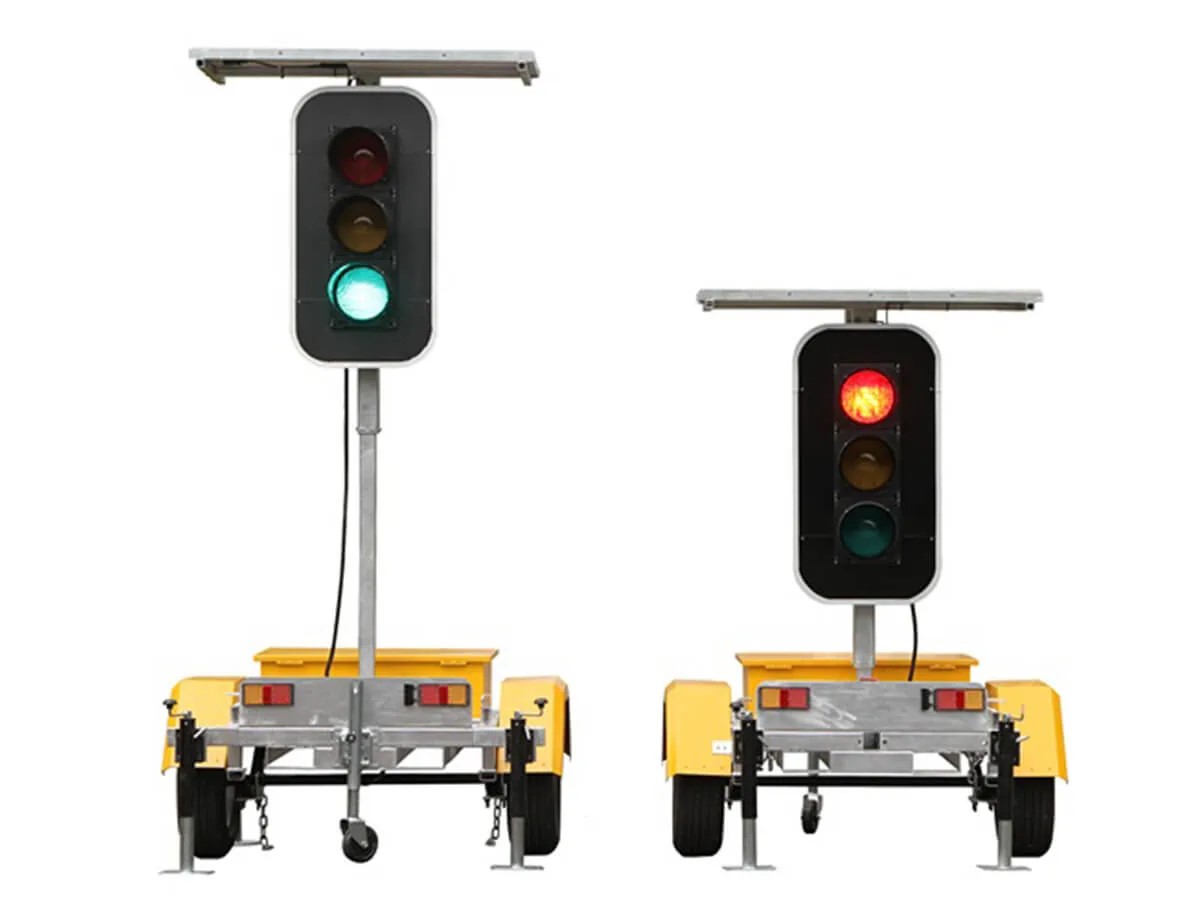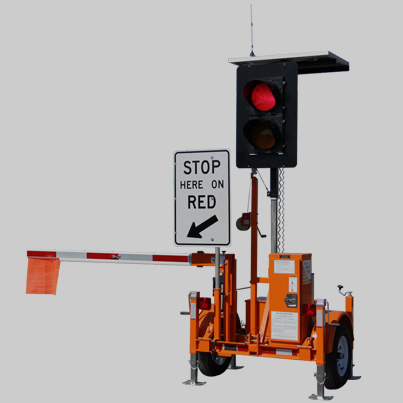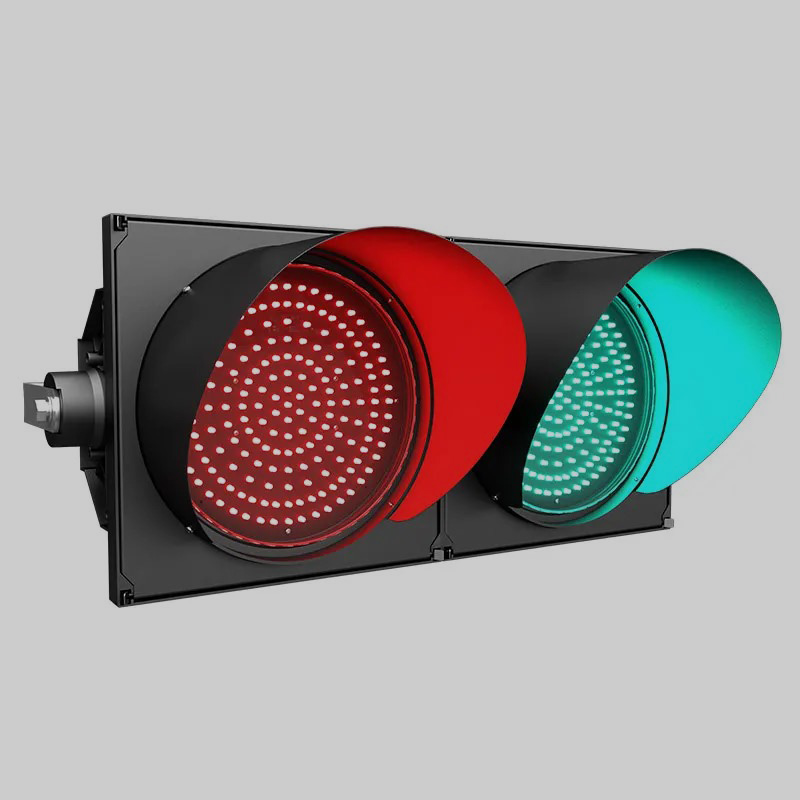Temporary traffic lights have significantly reduced the need for manually controlling traffic flow during short-term roadwork projects. Since it’s a cost-effective and intelligent traffic control solution, facilities, nowadays, are widely using them at worksites to effectively control traffic flow, while focusing on construction projects.
But how do temporary traffic lights work? That’s exactly what we’ve explained in this guide. You’ll learn what temporary traffic lights are, how they work, where they’re commonly used, and the key benefits they offer over permanent traffic signals. So, let’s get in.
What Are Temporary Traffic Lights?
Temporary traffic lights (often known as portable traffic lights) are a compact and movable version of traditional traffic lights, designed to manage vehicle and foot traffic flow temporarily. They include red, amber, and green LEDs, mounted with a pole on movable stands or trailers.
Traffic management or road construction companies generally install them during short-term construction projects, roadwork, or emergency repairs. They are also widely used at intersections where permanent signal lights are not needed, are malfunctioning, or are undergoing maintenance.

What Do Temporary Traffic Lights at Road Works Mean?
Temporary traffic lights at road works mean normal traffic flow or lanes have been altered due to temporary roadwork or a construction project. They basically guide drivers about road conditions and regulate traffic safely around construction or repair areas on the road.
Drivers should treat these traffic lights the same as permanent traffic signals and stop, proceed and drive cautiously, as per traffic light status. Since, these signal lights are not permanent, so they are kept placed until the road work is happening, to keep both drivers and workers safe.
How Do Temporary Traffic Lights Work?
Key Components of Temporary Traffic Lights
Jackwin manufactures temporary traffic signals with reliable components that can withstand harsh weather conditions and last longer to provide uninterrupted performance. Here is the list of core components portable traffic light include:

Signal Head:
The signal head is the black top part, where red, amber, and green LED lights are equipped, which direct traffic. This head is generally mounted to a vertical and adjustable stand for signal head visibility.
Control Unit:
This is a programmable box that controls the light timing, sequencing or responds to sensors. When its operation mode is set to automatic, control unit processes traffic volume data collected from sensors and adjusts the signal phase accordingly.
Vehicle Sensors:
The sensors play a significant role in smooth traffic flow. These sensors basically detect the total vehicular and pedestrian traffic volume in real-time and relay that data to the control unit, which then adjusts the signal light timing. The timing of how much time a signal light (suppose red) will stay.
Power Source:
Temporary traffic lights need uninterrupted power supply so that signal lights keep operating 24/7 without disruptions. That’s why portable traffic signal lights are often battery-powered or solar panel-powered, and few models powered using both.
Support Stand or Trailer:
A stable base, frame or even trailer can be used, which hold the vertical pole in place, to which signal lights are equipped. These stands can also be adjusted.
Working Mechanism of Temporary Traffic Lights
Once the temporary traffic lights are powered on, the control unit activates. From here, the operator or the facility that has installed signal lights will decide how the lights will function. The temporary traffic lights generally offer two operation modes: Manually or Automatically.
Manual Mode Operation
In manual mode, the operator has all control. Here’s how it works:
- First, the crew set the controller to manual mode. This can be done through either the built-in controller panel or a traffic signal remote.
- If using the remote: The operator needs to stand nearby (or at a safe viewing point) and using the remote, manually switches the lights between red to green, and then to amber and red again, based on real-time traffic conditions.
Note: This mode is especially useful in small-scale jobs or situations with irregular traffic, where an experienced crew can better judge the road conditions.
Automatic Sensor-Based Operation
In automatic mode, the traffic lights run on their own with the help of vehicle sensors:
- When sensor (or automatic) mode is selected, the infrared sensors detect the presence of vehicles in proximity.
- As soon as a vehicle is detected, waiting at the red light, the sensor sends a signal to the control unit.
- The controller unit then triggers the light sequence (Green).
- Once traffic passes or no more vehicles are detected, signal lights resets to red and allows the opposite direction to move.
Traffic Lights With Synchronization System
When multiple traffic lights are used at the worksite (for two-way or four-way control), facilities can leverage the traffic signal synchronization system to smoothly regulate junction traffic. This is done through syncing all traffic lights, which actually helps in ensuring that all lights change in coordination, preventing traffic conflicts and congestion.
Here’s how a traffic synchronization system works: Traffic light systems contain microcontrollers. These microcontrollers communicate with each other through serial buses and relay traffic volume and traffic patterns, which helps in adjusting the traffic lights accordingly.
How to Operate Temporary Traffic Lights Safely (For Workers) – Best Safety Tips
Below we have summarized a list of all safety-tips that help you to safely operate traffic light:
- Before setting up a traffic light, test all equipment, batteries, bulbs, control units, and sensors at your worksite.
- It is also recommended to always utilize proper signages, traffic cones, barriers, or warning signs, near your worksite. This step enhances visibility and ensures your workers’ safety.
- Since your team will be doing construction work on or along road, strictly ensure the entire team is wearing reflective vests, helmets, and gloves.
- If there are multiple traffic light units, before finalizing the setup, double-check and confirm the proper wireless linking between units to avoid conflicting signals.
- Avoid manually fixing green signal lights for longer as long timings should often pose traffic congestion or confusion.
- Frequently examine if the traffic light isn’t clearly seen at nighttime, use extra lighting or place reflective materials.
- Always keep a backup power source on-site, especially in long-duration or critical works.
- Have a technician available at the site, so if traffic lights malfunction, they can be repaired on time.
Temporary Traffic Lights Stuck on Red
If you’re at temporary traffic lights that are stuck on red, patiently wait for 2–3 full cycles (~3–5 minutes) and ensure your vehicle is close enough to stop line. The reason is that, portable traffic lights often have sensors, which solely rely on vehicle detection to trigger the green light.
If your vehicle isn’t detected within the sensor’s range, the signal may remain stuck on red. That’s why it’s important to pull your vehicle close enough to the sensor area (near the stop line) so the system can detect your vehicle.
In case you have waited long enough, the vehicle is pulled close too, and there’s no officer at the site to provide guidance regarding the traffic signal, you can proceed with caution and consider the site as a four-way stop (means yield for other vehicles and pedestrians).
Do Temporary Traffic Lights Have Cameras?
No, temporary traffic lights do not have a camera, as they are designed for general traffic regulation purposes. However, cameras can be used with temporary traffic lights for security purposes or monitoring workers’ activities on construction sites.
Permanent traffic lights, on the other hand, often have cameras for traffic laws and violations enforcement, but on temporary traffic lights, they cannot be used or nor do traffic violations enforcement.
Benefits of Temporary Traffic Signals vs Traditional Traffic Signals
The core purpose of traffic lights is to control traffic flow at intersections, so permanent traffic lights setup will always have priority over temporary traffic lights.
But for short-term roadworks, emergencies, or event projects, portable traffic signals provide several benefits versus traditional ones. They’re portable, cost-effective, quick to install, can be solar-powered or battery-operated, easier to relocate, require minimum infrastructure, and can be synchronized for multi-lane control.


Common Applications of Temporary Traffic Signals
| Use Case | Purpose |
| Roadworks | Here, it can be used to control one or two-lane traffic around construction or repairs. |
| Emergency Situations | During accidents or disasters, it can be used to redirect traffic. |
| Utility Maintenance | While repairing water, gas, or power lines, it can be used for traffic control. |
| Bridge/ Tunnel Closures | At such sites, a portable traffic light can safely control traffic when only one lane is open |
| Public Events | Can be used to direct vehicles near parades, marathons, or festivals |
| Railway Crossing Maintenance | Temporarily manage traffic when crossing systems are offline |
| Temporary Detours | Along with other traffic barricades, it can be used to restrict and guide traffic through new temporary routes |
| School or Pedestrian Zones | During repair work near such sites, movable traffic can be used to provide safe crossings. |
Temporary Traffic Lights for Sale
Discover our range of solar-powered mobile traffic lights, designed for managing traffic at temporary work zones, emergency situations, utility projects, and pedestrian crosswalks. They are easy-to-install, are weather-resistant, waterproof and come with a 3-year warranty.



JACKWIN’s Role in Temporary Traffic Lights
JACKWIN is the leading Chinese traffic signal lights’ manufacturer and supplier, selling portable signal lights to more than 50 countries since 2008, with a long warranty and great after-sales service. Our products are compliant with MUTCD standard, and are sold at competitive factory prices.
Our professional team can also customize a traffic-light solution for your needs, such as an intelligent traffic lights system connected to road studs, in intersections and crosswalks. Contact us today to get an instant inquiry!


-80x69.png)

